
|
ER 880 at the Aldwych terminus of the 9. This was the first of the 30 foot RM’s and the first 4 were classed as ER’s (ER 880-883) before being renumbered as RML 880. |
||
|
Between
2000 & 2005 Brian Burgess went on a quest to photograph as many of the remaining
Routemaster routes as possible before they finished. The effort resulted in
hundreds of images of London Transport Garages, Termini, Stands and, yes, some
Routemasters too. I am pleased to be able to display a selection of
Brian's images here. |
|||||
| Aldwych Terminus | Archway Terminus | Ash Grove Garage | Battersea Garage | Blackwall DLR Station Terminus | |
| Routes & Routemaster Images by Brian Burgess | |
|
Below
is an extract (Withdrawal from London) from a Wikipedia article on the
Routemaster - click this line for the full article. |
|
|
Note: Where known, the LTB Garage Code, displayed on the associated buses, has been added to the Garage name (in brackets). Most Garages and their codes were inherited from the many bus companies that merged into the LPTB in 1933 and so there is a varied method of coding, most of them relate to the company who originally owned the Garage before the grouping. Some codes seem to make sense, e.g. BW for Bow and WH for West Ham; but then there's J for Holloway and P for Old Kent Road!. Garage extensions, additions, closures and what constituted a fully serviceable garage makes for much difficulty in consistency & precision. |
|

|
ER 880 at the Aldwych terminus of the 9. This was the first of the 30 foot RM’s and the first 4 were classed as ER’s (ER 880-883) before being renumbered as RML 880. |
||

|
Ex. Stagecoach Lancashire RM in Ash Grove garage under storage for TfL. |

|
Ash Grove TfL storage Sept 2000, legal lettering on WLT 848. |

|
Ash Grove TfL storage Sept 2000. Cab interior of RM 848, WLT 848. Ex. Greater Reading Omnibus fleet No.40 (Not used) |

|
TfL RM’s in storage at Ash Grove garage. |

|
Ash Grove TfL storage Sept 2000. 735 DYE was RM1735. Ex. Greater Reading Omnibus fleet No.36. |

|
Ash Grove TfL storage Sept 2000. 650 DYE was RM1650. Ex. Greater Reading Omnibus fleet No.37. XYJ 440 was WLT 838, RM838. Ex. Greater Reading Omnibus fleet No.22. |

|
Ash Grove TfL storage Sept 2000. RM2060, ALM 60B ex Black Prince. |

|
Ash Grove TfL storage Sept 2000. RM2122, CUV 122C. Ex. Kerfoot Davies. |

|
RM45 (VLT 45) in storage at Ash Grove garage for Tfl in Sept 2000. Ex. Greater Reading Omnibus fleet No.12. |

|
RM 191 (VLT 191) being stored for TfL in Ash Grove garage, Sept 2000. Ex. Greater Reading Omnibus fleet No.11. |
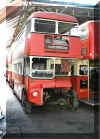
|
Ash Grove TfL RM stash Sept 2000. |
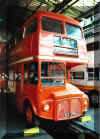
|
RM 1005 has lost it’s valuable number plate, 5 VLT for an age related replacement. She is in Ash Grove garage along with other RM’s destined for refurbishment and service with TfL. (Sept 2000) |
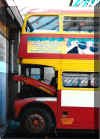
|
RM 2060 stored in Ash Grove garage as part of the TfL’s fleet of ‘reclaimed’ RM’s from all over the world, RM 346 & 713 came back to the UK from Italy! In all TfL bought 50 RM’s to refurbish. This was her in 2000; here is a photo taken of her in 2004 on route 38 after refurbishment. |
||

|
August 1997 & ERM80 awaits passengers at its pick up point by Charing Cross station. Originally RM80 was extended using parts of scrapped RM1329; then given the ‘Extended RM’ number ERM80. |

|
On a sunny Sunday in September 2000, some of Clapton’s fleet relax after a hectic week ploughing their trade across central London. |

|
RM5’s companion’s include another RM which is RM901 and sits 4th along the line of RMLs. |
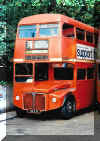
|
Resting somewhat without accolade and tucked in the corner is RM5, numerically the first production RM after the first four prototypes. RM5 was finally delivered to LT in June 1959, RM’s 6,9 & 11 appearing before her. (See her here on the last run day.) |
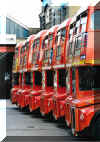
|
Some more of CT’s allocation rest up. |

|
Amongst the fleet keeping out of the sun inside CT is WLT888 which was one of the original batch of the 24 30’ buses which would become to be known as RML’s (see below). |

|
RML2552 is temporarily unfit for service, although she certainly is not unfit to become a design icon. |
|
The first four RML's were actually numbered as ER880-883, the ER standing for Extended Routemaster but this description was changed to RML in August 1961. If it ever goes quiet in the snug, just inform all and sundry that the 30' RML is actually 29 feet, 10 & 9/16ths inches long! (And that's just about 9,107.4875 mm, as if to demonstrate the beauty of fractions. Ed.) |
|||

|
Route 38 terminus at Clapton Pond. ALD 968B is RM1968 which was one of the refurbished TfL RM’s. The fixed windows on the upper deck are a ‘spotting’ feature. Behind her is RM2060 which is pictured here before refurbishment whilst stored in Ash Grove garage. |
||

|
Route 38 terminus at Clapton Pond. RML2122 on the stand. Upper deck front windows reveal her TfL refurbishment, compare to an ‘original’ front end on RML 901 on the same stand.] |

|
One of the granddads of the RML fleet entering service in Jan 1962, RML 901 (WLT 901) was over 5 years into her LT service before RML 2534 (JJD 534) behind joined the fleet. |

|
RML 2287 turns into the Clapton Pond stand for a rest after her trip from Victoria. She started serving London in 1965, although at a Country Bus garage, Godstone (GD), as cover until Lincoln Green RMLs arrived. |

|
RML 2304 also comes in for a rest. She was a garage mate of RML
2287 (left), also starting work at GD in 1965 in the familiar red
livery. |

|
RM 85, VLT 85 on the stand at Finsbury Park station sporting it’s RM50 vinyl. |

|
One of Battersea garage’s allocation, RM 346, SVS 615 (Ex. WLT 346) at it’s terminus at Finsbury Park station. |

|
RML 2542 rests up in Russell Square before running back to East Acton. The RMs on Route 7 were displaced on 2nd July 2004. |

|
Routes #6 & #9 lay over on their Strand Stand. |

|
Aug 1997 and the route 13 stand further along the Strand holds buses awaiting their return to Golders Green (Note the Sovereign take on LT bus red!) |

|
August 1997 and RML2693 has mechanical problems at the Strand bus stop whilst the resplendent doorman of the Waldorf Hotel looks on. |

|
August 1997 Whilst RML2693 suffers a breakdown on the Strand RMC1510 an ex Green Line 'coach' converted to an open topper, and being used on revenue service picks up. |

|
RML 2650 lays over in the Strand before struggling back across central London to Hammersmith. As can be seen, the bus is liveried for the 94 route which also runs from Shepherd’s Bush Garage (S) but has been called on to provide a runner for its sister route. The roof at some time appears to have lost an argument with some overhanging branches, judging by the dents and bumps along it. |
||

|
A rose between two thorns! RMC 1456 looks rather different from when she was delivered to Guildford garage in August 1962 to commence driver training on Green Line route 715 from Guildford to Hertford. She would have been resplendent in Lincoln Green with the Green Line roundel on the upper deck sides and the Green Line motif with a large initial G and final E with London Transport underneath on the lower deck sides. Seating on the RMC’s was reduced from the standard RM so that more legroom was given with seats which had a deeper squab for more comfortable seating on the long routes. Fluorescent lighting and luggage racks enhanced the ‘coach’ ambiance. When 1456 staggers into Upton Park garage after a hard day on London’s road, she will see her sister 1461 sitting there in original condition. Perhaps she dreams the night away remembering her Green Line days? |
||
|
Upton Park Garage dates from 1907, but it’s present configuration dates from an extensive rebuild in 1931. Compare the space available to manoeuvre buses here as opposed to Tottenham or Bow, which were built during the same era. |
|||

|
Upton Park Garage. |

|
RML 886 resting between runs in Upton Park Garage. Sept 2000. |

|
RMC 1461 was new to Guildford Country Bus garage in August 1962 and is seen here nicely preserved by Stagecoach in its original livery & her original registration. |

|
RMC 1461 sits alongside RM 613 who has 6 years seniority over RML 2641 (Into service 1961/67). |
|
I wonder if RMC 1456, pictured here at Blackwall DLR above in this gallery which also lives in ‘U’, feels slightly jealous of her sister RMC1461 who has retained its splendid Green Line livery? Above (right) RMC 1461 shows the ‘as delivered’ look of the RMC’s into Green Line service; the original luggage racks remain in place and are visible through the windows. |
|||